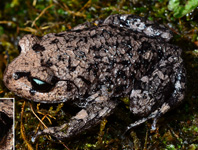Abstract
Pterovianaida duckensis n. sp., a new macropterous species of the rarely collected subfamily Vianaidinae is here described. The group currently comprises nine species, two of them fossils. Pterovianaida Montemayor and Carpintero is a recent monotypic genus described for a macropterous species collected in Peru. Here, a new macropterous species of Pterovianaida is described, and characters of the head, pronotum and hemelytra distinguish this species from the type species. This is the first record of a macropterous Vianaidinae for Brazil. A key to all extant species of this subfamily is provided.
References
China, W.E. (1945) A completely blind bug of the family Lygaeidae (Hemiptera-Heteroptera). Proceedings of the Royal Entomological Society of London, 14 (9–-10), 126–128.
http://dx.doi.org/10.1111/j.1365-3113.1945.tb00375.xDoesburg, P.H. van (1977) A new species of Thaumamannia from Surinam (Heteroptera, Tingidae, Vianaidinae). Zoologische Mededelingen, 52 (14), 187–189.
Drake, C.J. & Davis, N.T. (1960) The morphology, phylogeny, and higher classification of the family Tingidae, including the description of a new genus and species of the subfamily Vianaidinae (Hemiptera: Heteroptera). Entomologica Americana, 39, 1–100.
Drake, C.J. & Froeschner, R. (1962) A new myrmecophilous lacebug from Panama (Hemiptera: Tingidae). The Great Basin Naturalist, 22 (1–3), 8–11.
Drake, C.J. & Ruhoff, F.A. (1965) Lacebugs of the World: A Catalog (Hemiptera: Tingidae). United States National Museum Bulletin, 243, 1–634.
http://dx.doi.org/10.5479/si.03629236.243.1
Golub, V.B. (2001) Archepopovia yurii n. gen. n. sp. a new remarkable lace bug from Baltic amber, with some notes on phylogeny and classification of Tingidae (Heteroptera, Tingidae). Mitteilungen aus dem Geologisch-Palaontologischen Institut der Universitat Hamburg, 85, 263–276.
Golub, V.B. & Popov, Y.A. (2000) A remarkable fossil lace bug from Upper Cretaceous New jersey Jersey amber (Heteroptera: Tingoidea, Vianaididae), with some phylogenetic commentary. In: Grimaldi, D. (Eds), Studies on Fossils in amber, with particular reference to the Cretaceous of New Jersey. Backhuys Leiden, pp. 231–239.
Golub, V.B. & Popov, Y.A. (2003) The new fossil genus of Vianaididae (Heteroptera: Tingoidea) from the Cretaceous amber of New Jersey; evolution of the family in the Late Cretaceous. Acta Zoologica Cracoviensia, 46, 109–116.
Guidoti, M., Barcellos, A. & Ferreira, R.L. (2014) Novelties from a cave lace bug (Heteroptera, Tingidae): first nymphal description with a discussion on the morphological patterns of Vianaidinae immatures. Iheríngia, Série Zoologia, 104 (1), 99–103.
http://dx.doi.org/10.1590/1678-47662014104199103Guilbert, E. (2001) Phylogeny and evolution of exaggerated traits among the Tingidae (Heteroptera, Cimicomorpha). Zoologica Scripta, 30 (4), 313–324.
http://dx.doi.org/10.1046/j.1463-6409.2001.00069.x
Guilbert, E. (2004) Do larvae evolve the same way as adults in Tingidae (Insecta: Heteroptera)? Cladistics, 20, 139–150.
http://dx.doi.org/10.1111/j.1096-0031.2004.00015.xGuilbert, E. (2012a) Phylogeny of Cantacaderinae (Heteroptera: Tingidae) revisited after the description of a new genus and new species from New Caledonia. European Journal of Entomology, 109, 111–116.
http://dx.doi.org/10.14411/eje.2012.014Guilbert, E. (2012b) Biogeography of the Cantacaderinae Stål (Insecta: Heteroptera: Tingidae) revisited. Invertebrate Systematics, 26, 316–322.
http://dx.doi.org/10.1071/IS12010Heiss, E. & Guilbert, E. (2013) Two new genera and species of Tingidae from Cretaceous amber from Myanmar (Burma) (Hemiptera: Heteroptera). Zootaxa, 3736 (4), 379–386.
http://dx.doi.org/10.11646/zootaxa.3736.4.5Kormilev, N.A. (1955) A new myrmecophil family of Hemiptera from the delta of Rio Parana, Argentina. Revista Ecuatoriana de Entomologia y Parasitologia, 2 (3–4), 465–477.
Lis, B. (1999) Phylogeny and classification of Cantacaderini [= Cantacaderidae stat. nov.] (Hemiptera: Tingoidea). Annales Zoologici, 49 (3), 157–196.
Montemayor, S.I. & Carpintero, D.L. (2007) A new macropterous genus with a new species of Vianaididae (Heteroptera, Tingoidea, Vianaididae) from Peru. Studies on Neotropical Fauna and Environment, 42 (2), 133–136.
http://dx.doi.org/10.1080/01650520600997611Schuh, R.T. & Slater, J.A. (1995) True Bugs of the World (Hemiptera: Heteroptera), Classification and Natural History. Cornell University Press New York, 337 pp.
Schuh, R.T. & Stys, P. (1991) Phylogenetic analysis of cimicomorphan family relationships (Heteroptera). Journal of the New York Entomological Society, 99 (3), 298–350.
Schuh, R.T., Cassis, G. & Guilbert, E. (2006) Description of the first recent macropterous species of Vianaidinae (Heteroptera: Tingidae) with comments on the phylogenetic relationships of the family within the Cimicomorpha. Journal of the New York Entomological Society, 114 (1–2), 38–53.
http://dx.doi.org/10.1664/0028-7199(2006)114[38:DOTFRM]2.0.CO;2Schuh, R.T., Weirauch, C. & Wheeler, W.C. (2009) Phylogenetic relationships within the Cimicomorpha (Hemiptera: Heteroptera): a total-evidence analysis. Systematic Entomology, 34, 15–48.
http://dx.doi.org/10.1111/j.1365-3113.2008.00436.x

